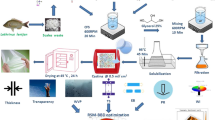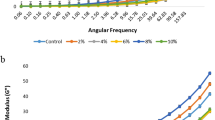Abstract
This study investigated the optimization of chicken skin gelatin film production using different concentrations of glycerol as plasticizer, specifically for use as biodegradable food packaging. Response surface methodology (RSM) was used to optimize the production of gelatin films by following a central composite design (CCD) for two quantitative modulators—(A) gelatin at 1.0, 2.5 and 4.0 g; and (B) glycerol at 0, 0.75, 1.50 g—with outcome metrics to predict tensile strength (TS), elongation at break (EAB) and water vapor permeability (WVP). Potentially optimized conditions were experimentally validated to confirm the model’s suggestions of 4.0 g for gelatin and 1.5 g for glycerol. Experimental results yielded a TS of 3.81 N/mm, which was higher than the RSM predicted value of 3.09 N/mm (p < 0.05). Both EAB and WVP experimental results were slightly lower than predicted values (3.04 vs. 3.14%) (p < 0.05); and (1.27 × 10−9 vs. 1.31 × 10−9 kPa) (p < 0.05), respectively. Overall, experimental results agreed with the model’s predicted values. Hence, this study demonstrates that optimized conditions for the production of chicken skin gelatin films are affected by glycerol concentration and gelatin quantity. Results also suggest that chicken skin gelatin–glycerol film blends have excellent potential for the production of biodegradable food packaging with improved properties.

Similar content being viewed by others
References
Ahmad M, Benjakul S, Prodpran T, Agustini TW (2012) Physico-mechanical and antimicrobial properties of gelatin film from the skin of unicorn leatherjacket incorporated with essential oils. Food Hydrocoll 28(1):189–199
Al-Hassan AA, Norziah MH (2012) Starch–gelatin edible films: water vapor permeability and mechanical properties as affected by plasticizers. Food Hydrocoll 26(1):108–177
Andrade-Mahecha MM, Tapia-Blácido DR, Menegalli FC (2012) Development and optimization of biodegradable films based on achira flour. Carbohydr Polym 88(2):449–458
AOAC (2006) Official methods of analysis of AOAC international, 18th edn. Association of Official and Analytical Chemists International, Virginia
ASTM (1997) Designation D 882-97: standard test method for tensile properties of thin plastic sheeting. In: Annual book of ASTM standards. American Society for Testing and Materials, Philadelphia, p 159
Bergo P, Sobral PJA (2007) Effects of plasticizer on physical properties of pigskin gelatin films. Food Hydrocoll 21(8):1285–1289
Bhat R, Karim AA (2014) Towards producing novel fish gelatin films by combination treatments of ultraviolet radiation and sugars (ribose and lactose) as cross-linking agents. J Food Sci Technol 51(7):1326–1333
Canettieri EV, De Moraes Rocha GJ, De Carvalho JA, De Silva JBDA (2007) Optimization of acid hydrolysis from the hemicellulosic fraction of Eucalyptus grandis residue using response surface methodology. Bioresour Technol 98(2):422–428
Cao N, Yang X, Fu Y (2009) Effects of various plasticizers on mechanical and water vapor barrier properties of gelatin films. Food Hydrocoll 23(3):729–735
Carvalho RA, Maria TMC, Moraes ICF, Bergo PVA, Kamimura ES, Habitante AMQB, Sobral PJA (2009) Study of some physical properties of biodegradable films based on blends of gelatin and poly(vinyl alcohol) using response surface methodology. Mater Sci Eng 29(2):485–491
Cheng M, Deng J, Yang F, Gong Y, Zhao N, Zhang X (2003) Study on physical properties and nerve cell affinity of composite films from chitosan and gelatin solutions. Biomaterials 24(17):2871–2880
Fakhouri FM, Costa D, Yamashita F, Martelli SM, Jesus RC, Alganer K, Innocentini-Mei LH (2013) Comparative study of processing methods for starch/gelatin films. Carbohydr Polym 95(2):681–689
Gómez-Guillén MC, Giménez B, López-Caballero MA, Montero MP (2011) Functional and bioactive properties of collagen and gelatin from alternative sources: a review. Food Hydrocoll 25(8):1813–1827
Guan X, Yao H (2008) Optimization of Viscozyme L-assisted extraction of oat bran protein using response surface methodology. Food Chem 106(1):345–351
Hanani ZN, Roos YH, Kerry JP (2012) Use of beef, pork and fish gelatin sources in the manufacture of films and assessment of their composition and mechanical properties. Food Hydrocoll 29(1):144–151
Hanani ZN, Roos YH, Kerry JP (2014) Use and application of gelatin as potential biodegradable packaging materials for food products. Int J Biol Macromol 71:94–102
Hoque MS, Benjakul S, Prodpran T (2011) Effects of partial hydrolysis and plasticizer content on the properties of film from cuttlefish (Sepia pharaonis) skin gelatin. Food Hydrocoll 25(1):82–90
Jiang M, Liu S, Du X, Wang Y (2010) Physical properties and internal microstructures of films made from catfish skin gelatin and triacetin mixtures. Food Hydrocoll 24(1):105–110
Jongjareonrak A, Benjakul S, Visessanguan W, Prodpran T, Tanaka M (2006) Characterization of edible films from skin gelatin of brownstripe red snapper and bigeye snapper. Food Hydrocoll 20(4):492–501
Leerahawong A, Tanaka M, Okazaki E, Osako K (2011) Effects of plasticizer type and concentration on the physicochemical properties of edible film from squid (Todarodes pacificus) mantle muscle. Fish Sci 77(6):1061–1068
Maache-Rezzoug Z, Pierre G, Nouviaire A, Maugard T, Rezzoug SA (2011) Optimizing thermomechanical pretreatment conditions to enhance enzymatic hydrolysis of wheat straw by response surface methodology. Biomass Bioenergy 35(7):3129–3138
Maran JP, Sivakumar V, Sridhar R, Thirugnanasambandham K (2013a) Response surface modeling and analysis of barrier and optical properties of maize starch edible films. Int J Biol Macromol 60:412–421
Maran JP, Sivakumar V, Sridhar R, Thirugnanasambandham K (2013b) Development of model for barrier and optical properties of tapioca starch based edible films. Carbohydr Polym 92(2):1335–1347
Ozdemir M, Ozen BF, Dock LL, Floros JD (2008) Optimization of osmotic dehydration of diced green peppers by response surface methodology. LWT Food Sci Technol 41(10):2044–2050
Rao MS, Kanatt SR, Chawla SP, Sharma A (2010) Chitosan and guar gum composite films: preparation, physical, mechanical and antimicrobial properties. Carbohydr Polym 82(4):1243–1247
Rhim JW, Park HM, Ha CS (2013) Bio-nanocomposites for food packaging applications. Progr Polym Sci 38(10):1629–1652
Sarbon NM, Badii F, Howell NK (2013) Preparation and characterisation of chicken skin gelatin as an alternative to mammalian gelatin. Food Hydrocoll 30(1):143–151
Siracusa V (2012) Food packaging permeability behavior: a report. Int J Polym Sci 1:1–11
Su JF, Huang Z, Yuan XY, Wang XY, Li M (2010) Structure and properties of carboxymethyl cellulose/soy protein isolate blend edible films crosslinked by Maillard reactions. Carbohydr Polym 79(1):145–153
Suderman N, Isa MIN, Sarbon NM (2016) Effect of drying temperature on the functional properties of biodegradable CMC-based film for potential food packaging. Int Food Res J 23(3):1075–1084
Taghian Dinani S, Hamdami N, Shahedi M, Keramat J (2014) Optimization of carboxymethyl cellulose and calcium chloride dip-coating on mushroom slices prior to hot air drying using response surface methodology. J Food Process Preserv 38(3):1269–1278
Tapia-Blacido DR, Do Amaral Sobral PJ, Menegalli FC (2011) Optimization of amaranth flour films plasticized with glycerol and sorbitol by multi-response analysis. LWT Food Sci Technol 44:1731–1738
Thomazine M, Carvalho RA, Sobral PJ (2005) Physical properties of gelatin films plasticized by blends of glycerol and sorbitol. J Food Scie 70(3):E172–E176
Tongnuanchan P, Benjakul S, Prodpran T (2012) Properties and antioxidant activity of fish skin gelatin film incorporated with citrus essential oils. Food Chem 134(3):1571–1579
Vanin FM, Sobral PJA, Menegalli FC, Carvalho RA, Habitante AMQB (2005) Effects of plasticizers and their concentrations on thermal and functional properties of gelatin-based films. Food Hydrocoll 19(5):899–907
Voon HC, Bhat R, Easa AM, Liong MT, Karim AA (2012) Effect of addition of halloysite nanoclay and SiO2 nanoparticles on barrier and mechanical properties of bovine gelatin films. Food Bioprocess Technol 5(5):1766–1774
Author information
Authors and Affiliations
Corresponding author
Additional information
Publisher's Note
Springer Nature remains neutral with regard to jurisdictional claims in published maps and institutional affiliations.
Rights and permissions
About this article
Cite this article
Suderman, N., Sarbon, N.M. Optimization of chicken skin gelatin film production with different glycerol concentrations by response surface methodology (RSM) approach. J Food Sci Technol 57, 463–472 (2020). https://doi.org/10.1007/s13197-019-04074-0
Revised:
Accepted:
Published:
Issue Date:
DOI: https://doi.org/10.1007/s13197-019-04074-0




